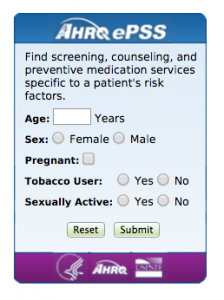By Quyen Ngo-Metzger, MD, MPH, Scientific Director, U.S. Preventive Services Task Force Program; Agency for Healthcare Research and Quality and Amanda E. Borsky, DrPH, MPP, Dissemination & Implementation Advisor, U.S. Preventive Services Task Force Program, Agency for Healthcare Research and Quality
The U.S. Preventive Services Task Force (USPSTF) plays a role unlike any other in the Nation’s health care system. This independent body of volunteer medical experts helps clinicians evaluate and apply preventive health care services for patients with no recognized signs or symptoms of disease. Their recommendations aim to help primary care clinicians and patients decide together whether a preventive service is right for a patient’s needs.
The potential value of these services — screening, counseling services, and preventive medicines — is enormous, whether measured in suffering avoided or lives saved. But how can clinicians effectively navigate and apply more than 90 recommendations authored by the Task Force?
There are several key activities that the USPSTF uses to disseminate its recommendations.
For clinicians:
- Electronic Preventive Services Selector (ePSS) is a website and mobile app that allows clinicians to identify which preventive services are right for their patients. Clinicians enter their patient’s age, sex, and whether or not the patient is pregnant, a tobacco user, or sexually active. Clinicians then get a list of the preventive services recommended for the patient. The USPSTF ePSS website gets about 2.7 million visits per year. In 2016, the mobile app was downloaded to almost 74,000 smartphones or iPads. And over 55 vendors use ePSS to access and use the data within their own applications, including electronic health record vendors and others.
- The Journal of the American Medical Association (JAMA) website publishes all of the USPSTF final recommendation statements and evidence summaries, as well as a page for patients and audio podcasts to help explain recommendations in plain language. The 2016 recommendations published on the JAMA website have received an average of nearly 55,000 views (views ranged from 16,000 to 192,000).
- Other USPSTF website materials include an email list to help the public stay up-to-date on USPSTF activities, including public comment periods (over 44,000 individuals are currently signed up for the listserv).
For your patients:
- The healthfinder website is designed to be easy for patients to use to learn more about prevention and find the right preventive services for them. Patients can enter their age, sex, and pregnancy status into the myhealthfinder tool and get a list of the preventive services recommended for them. Patients can also access information about a variety of health topics. Clinicians can also share information from this website with their patients and easily add myhealthfinder to their website, patient portal, or blog through a widget or application programming interfaces (API).
- Other USPSTF website materials include an email list to help the public stay up-to-date on USPSTF activities, including public comment periods (over 44,000 individuals are currently signed up for the listserv currently). USPSTF also offers plain language summaries of recommendations for consumers and patients.
The USPSTF recognizes the importance of not only developing evidence-based recommendations, but also disseminating the recommendations to help make sure that primary care clinicians and patients have the best information available to make informed decisions for their care.
